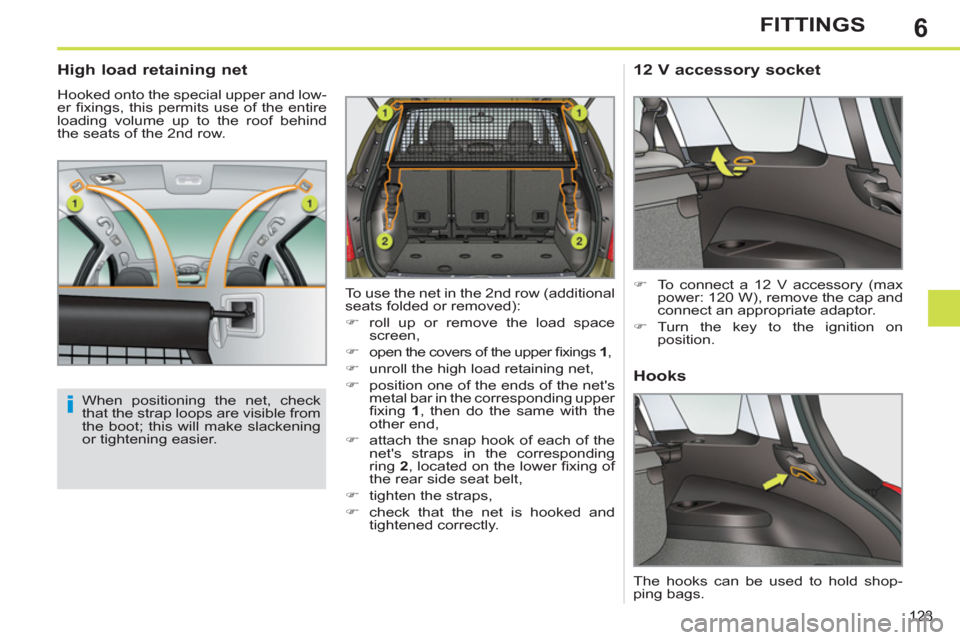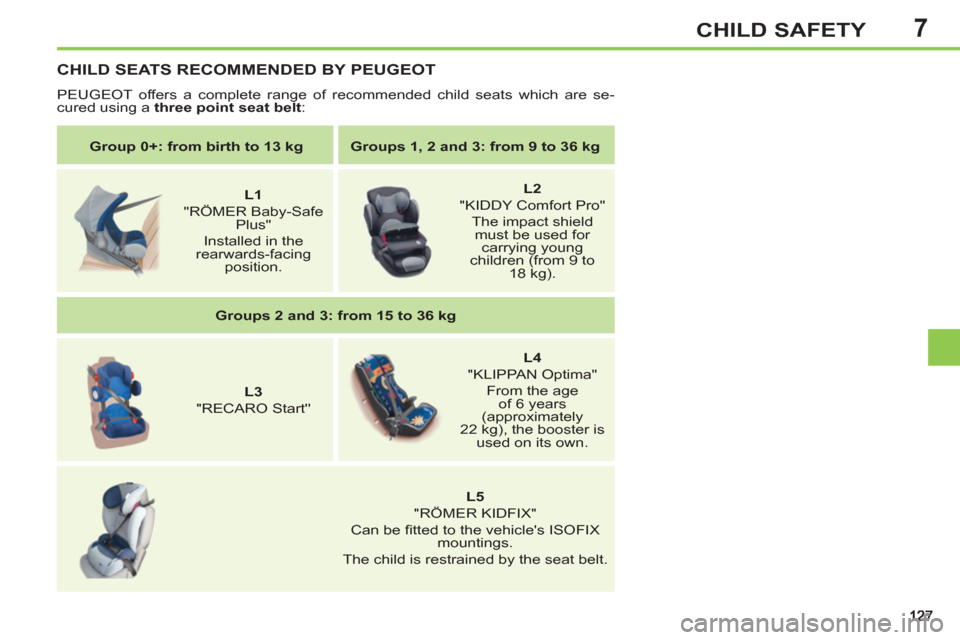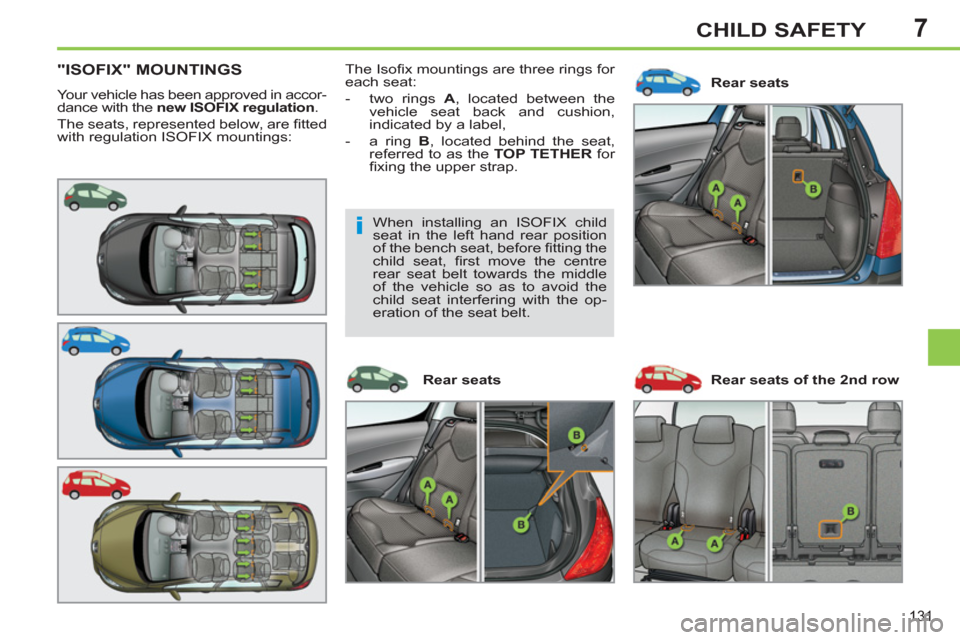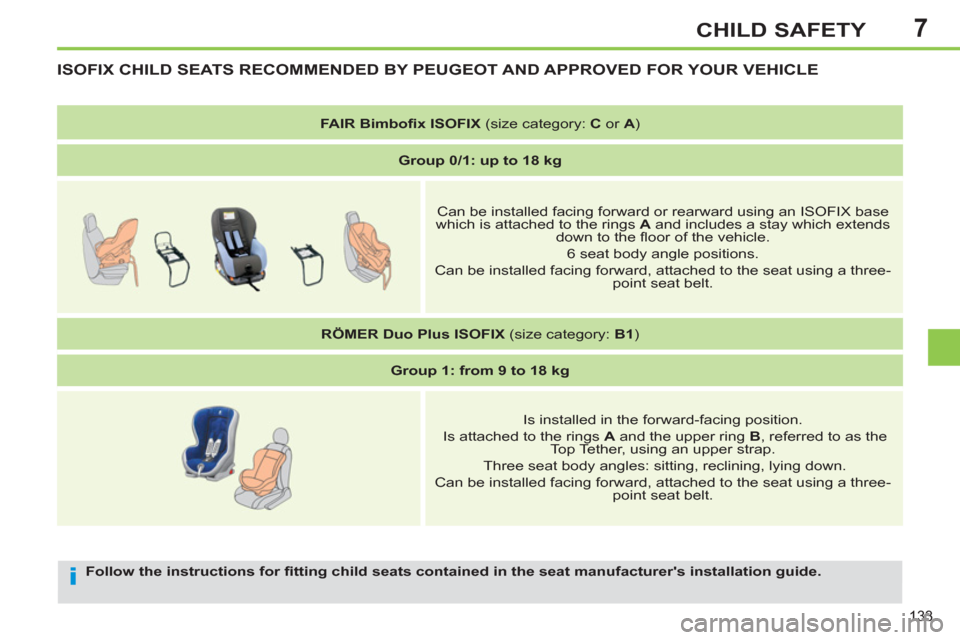2013 Peugeot 308 SW BL belt
[x] Cancel search: beltPage 125 of 382

6
123
FITTINGS
High load retaining net
Hooked onto the special upper and low-
er fi xings, this permits use of the entire
loading volume up to the roof behind
the seats of the 2nd row.
12 V accessory socket
�)
To connect a 12 V accessory (max
power: 120 W), remove the cap and
connect an appropriate adaptor.
�)
Turn the key to the ignition on
position.
To use the net in the 2nd row (additional
seats folded or removed):
�)
roll up or remove the load space
screen,
�)
open the covers of the upper fi xings 1
,
�)
unroll the high load retaining net,
�)
position one of the ends of the net's
metal bar in the corresponding upper
fi xing 1
, then do the same with the
other end,
�)
attach the snap hook of each of the
net's straps in the corresponding
ring 2
, located on the lower fi xing of
the rear side seat belt,
�)
tighten the straps,
�)
check that the net is hooked and
tightened correctly.
When positioning the net, check
that the strap loops are visible from
the boot; this will make slackening
or tightening easier.
Hooks
The hooks can be used to hold shop-
ping bags.
Page 127 of 382

7
125
CHILD SAFETY
PEUGEOT recommends
that chil-
dren should travel in the rear seats
of your vehicle:
- "rearwards-facing"
up to the
age of 2,
- "forwards-facing"
over the
age of 2.
GENERAL POINTS RELATINGTO CHILD SEATSCHILD SEAT IN THE FRONT
"Forwards-facing"
When a "forwards-facing" child seat is
installed on the front passenger seat
,
adjust the vehicle's seat to the interme-
diate longitudinal position with the seat
back upright and leave the passenger
airbag activated.
"Rearwards-facing"
When a "rearwards-facing" child seat is
installed on the front passenger seat
,
it is essential that the passenger airbag
is deactivated. Otherwise, the child
would risk being seriously injured or
killed if the airbag were to infl ate
.
*
The rules for carrying children are
specifi c to each country. Refer to the
current legislation in your country. Although one of PEUGEOT's main cri-
teria when designing your vehicle, the
safety of your children also depends on
you.
For maximum safety, please observe
the following recommendations:
- in accordance with European
regulations, all children under the
age of 12 or less than one and
a half metres tall must travel in
approved child seats suited to
their weight
, on seats fi tted with a
seat belt or ISOFIX mountings * ,
- statistically, the safest seats in
your vehicle for carrying children
are the rear seats,
- a child weighing less than 9 kg
must travel in the "rearwards-
facing" position both in the front
and in the rear.
Intermediate longitudinal position
Page 129 of 382

7CHILD SAFETY
Group 0+: from birth to 13 kg
Groups 1, 2 and 3: from 9 to 36 kg
L1
"RÖMER Baby-Safe
Plus"
Installed in the
rearwards-facing
position.
L2
"KIDDY Comfort Pro"
The impact shield
must be used for
carrying young
children (from 9 to
18 kg).
Groups 2 and 3: from 15 to 36 kg
L3
"RECARO Start''
L4
"KLIPPAN Optima"
From the age
of 6 years
(approximately
22 kg), the booster is
used on its own.
L5
"RÖMER KIDFIX"
Can be fi tted to the vehicle's ISOFIX
mountings.
The child is restrained by the seat belt.
CHILD SEATS RECOMMENDED BY PEUGEOT
PEUGEOT offers a complete range of recommended child seats which are se-
cured using a three point seat belt
:
Page 130 of 382

7
128
CHILD SAFETY
LOCATIONS FOR CHILD SEATS SECURED USING THE SEAT BELT
In accordance with European regulations, this table indicates the options for installing child seats secured using
the seat belt and universally approved (a) in relation to the weight of the child and the seat in the vehicle.
(a) Universal child seat: child seat which can be installed in all vehicles using the seat belt.
(b) Group 0: from birth to 10 kg. Infant car seats and "car cots" cannot be installed on the front passenger seat.
(c) Consult the legislation in force in your country before installing your child on this seat.
U
: seat suitable for the installation of a child seat secured using the seat belt and universally approved "rear facing" and/or
"forward facing".
U(R1)
: identical to U
, with the vehicle's seat adjusted to the intermediate longitudinal position.
U(R2)
: identical to U
, with the vehicle's seat adjusted to the highest position and moved back fully.
*
The seat's head restraint must be removed and stored.
Seat
Weight of the child /
indicative age
Less than 13 kg
(groups 0 (b)
and 0+)
Up to ≈ 1 year
From 9 to 18 kg
(group 1)
From 1 to ≈ 3 years
From 15 to 25 kg
(group 2)
From 3 to ≈ 6 years
From 22 to 36 kg
(group 3)
From 6 to ≈ 10 years
Front passenger seat (c)
- fi xed
U(R1)
U(R1)
U(R1)
U(R1)
- height adjustable
U(R2)
U(R2)
U(R2)
U(R2)
Outer rear seats
U
U
*
U
*
U
*
Centre rear seat
U
U
*
U
*
U
*
Page 131 of 382

7
129
CHILD SAFETY
LOCATION OF CHILD SEATS SECURED USING THE SEAT BELT
In accordance with the European regulation, this table indicates the options for the installation of child seats se-
cured using the seat belt and universally approved (a) depending on the weight of the child and the seat in the
vehicle.
(a) Universal child seat: child seat which
can be installed in all vehicles using
the seat belt.
(b) Group 0: from birth to 10 kg. Infant
car seats and "car cots" cannot be
installed on the front passenger
seat.
Seat
Weight of the child
/indicative age
Below 13 kg
(groups 0 (b)
and 0+)
Up to ≈ 1 year
9 to 18 kg
(group 1)
From 1 to ≈ 3 years
15 to 25 kg
(group 2)
From 3 to ≈ 6 years
22 to 36 kg
(group 3)
From 6 to ≈ 10 years
1st
row
Front passenger seat (c)
- fi xed
U(R1)
U(R1)
U(R1)
U(R1)
- height adjustable
U(R2)
U(R2)
U(R2)
U(R2)
2nd
row
Outer
Seat in standard position
and moved inwards
U
U
U
U
Centre
Centre seat
U
U
U
U
3rd
row
Outer
Additional seat
U
U
U
U
Outer
2nd row seat
U
U
U
U
(c) Consult the current legislation in
your country before installing your
child on this seat.
U
: seat suitable for the installation of a
child seat secured using the seat belt
and universally approved, "rear fac-
ing" and/or "forwards facing".
U(R1)
: identical to U
, with the vehicle's
seat adjusted to the intermedi-
ate longitudinal position.
U(R2)
: identical to U
, with the vehicle's
seat adjusted to its highest posi-
tion and moved back fully.
Page 132 of 382

7
130
CHILD SAFETY
ADVICE ON CHILD SEATS
Installing a booster seat
The chest part of the seat belt must
be positioned on the child's shoulder
without touching the neck.
Ensure that the lap part of the seat
belt passes correctly over the child's
thighs.
PEUGEOT recommends the use of
a booster seat which has a back, fi t-
ted with a seat belt guide at shoulder
level.
As a safety precaution, do not leave:
- a child or children alone and
unsupervised in a vehicle,
- a child or an animal in a vehicle
which is exposed to the sun, with
the windows closed,
- the keys within reach of children
inside the vehicle.
To prevent accidental opening of the
doors and rear windows, use the
"Child lock".
Take care not to open the rear win-
dows by more than one third.
To protect young children from the
rays of the sun, fi t side blinds on the
rear windows.
The incorrect installation of a child
seat in a vehicle compromises the
child's protection in the event of an ac-
cident.
Remember to fasten the seat belts or
the child seat harnesses keeping the
slack relative to the child's body to a
minimum, even for short journeys.
When installing a child seat using the
seat belt, ensure that the seat belt is
tightened correctly on the child seat
and that it secures the child seat fi rm-
ly on the seat of your vehicle. If your
passenger seat is adjustable, move it
forwards if necessary.
For optimum installation of the "for-
wards-facing" child seat, ensure that
the back of the child seat is in contact
with the back of the vehicle's seat and
that the head restraint does not cause
any discomfort.
If the head restraint has to be removed,
ensure that it is stored or attached se-
curely to prevent it from being thrown
around the vehicle in the event of sharp
braking. Children under the age of 10 must not
travel in the "forwards-facing" position
on the front passenger seat, unless
the rear seats are already occupied
by other children, cannot be used or
are absent.
Deactivate the passenger airbag
when a "rearwards-facing" child seat
is installed on the front seat.
Otherwise, the child would risk being
seriously injured or killed if the airbag
were to infl ate.
Page 133 of 382

7
131
CHILD SAFETY
"ISOFIX" MOUNTINGS
Your vehicle has been approved in accor-
dance with the new ISOFIX regulation
.
The seats, represented below, are fi tted
with regulation ISOFIX mountings: Rear seats The Isofi x mountings are three rings for
each seat:
- two rings A
, located between the
vehicle seat back and cushion,
indicated by a label,
- a ring B
, located behind the seat,
referred to as the TOP TETHER
for
fi xing the upper strap.
Rear seats Rear seats of the 2nd row
When installing an ISOFIX child
seat in the left hand rear position
of the bench seat, before fi tting the
child seat, fi rst move the centre
rear seat belt towards the middle
of the vehicle so as to avoid the
child seat interfering with the op-
eration of the seat belt.
Page 135 of 382

7
133
CHILD SAFETY
Follow the instructions for fi tting child seats contained in the seat manufacturer's installation guide.
ISOFIX CHILD SEATS RECOMMENDED BY PEUGEOT AND APPROVED FOR YOUR VEHICLE
FAIR Bimbofi x ISOFIX
(size category: C
or A
)
Group 0/1: up to 18 kg
Can be installed facing forward or rearward using an ISOFIX base
which is attached to the rings A
and includes a stay which extends
down to the fl oor of the vehicle.
6 seat body angle positions.
Can be installed facing forward, attached to the seat using a three-
point seat belt.
RÖMER Duo Plus ISOFIX
(size category: B1
)
Group 1: from 9 to 18 kg
Is installed in the forward-facing position.
Is attached to the rings A
and the upper ring B
, referred to as the
Top Tether, using an upper strap.
Three seat body angles: sitting, reclining, lying down.
Can be installed facing forward, attached to the seat using a three-
point seat belt.